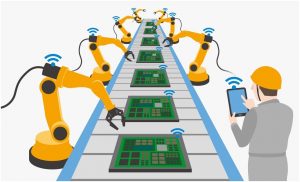This blog was originally published in July 2020.
Introduction
5G is often thought of as simply the next generation of cellular technology, supporting higher fidelity communication and faster data downloads. However, that is just a part of the picture. 5G is much more ambitious in scope than prior generations, with specifications intended to reach far beyond consumer mobile.
There is no doubt that 5G will play a key role in industry digitalization, the ongoing transformation of business operations through digital technologies. Leveraging the industrial internet of things (IIoT), 5G will wirelessly connect all parts of the operation, driving smart manufacturing and enabling digital twins that can predict and optimize performance in real-time. While 4G was designed originally for optimized voice communication, 5G has been designed for data communication from the outset and its performance metrics in areas of key interest to manufacturing are vastly improved. 5G will ultimately add value by increasing productivity, reducing time to market, and lowering development and deployment risks across global operations and supply chains.
5G Deployment Challenges

Extending or replacing traditional wired industrial networks with 5G requires large investments in time and money for network equipment, large numbers of IIoT devices and edge computing infrastructure.
Additionally, industrial manufacturing environments are dynamic and full of metal machines and parts, some in constant motion. This creates significant challenges for deploying reliable 5G communication systems for industrial applications. Poor coverage or signal blocking, premature failure of equipment or problems discovered late in deployment could all cause significant delays and expense.
Substantial challenges are created by accommodating legacy communication standards, operating across multiple frequency bands or by building a private network in close proximity to a public network. Other industrial processes and sensors using radio frequencies can also pose interference risks.

To ensure good 5G indoor coverage, technicians must measure field strength wherever a person or IoT device is likely to be. This is challenging due to potentially the dangerous environment with moving machinery or dangerous chemicals and the sheer scale and height of a modern facility where drones may have to be used for example, to measure fields above the factory or distribution center floor. Manufacturing and product teams and network providers must collaborate to select and position transmit/receive points and IIoT devices to achieve maximum coverage under the full range of operating conditions. They must also ensure robustness and reliability of devices to thermal or mechanical shock to avoid a weak link in the overall 5G network.
Additionally EMF (electric field) must be considered to ensure that the total exposure does not exceed the regulated maximum for personal exposure.
Solutions

Modeling and simulation can reduce risks and costs by not only supplementing measurement in complex industrial environments, but by allowing different configurations to be analyzed and optimized from the very beginning of the development cycle. Engineers can perform a variety of multiphysics simulations in order to ensure a robust design before physical deployment, including:
Electromagnetic: Antenna efficiency and pattern, co-site interference, signal integrity, human exposure (specific absorption rate, SAR)
Structural: Strength and durability of devices, fatigue, drop and impact testing
Thermal: Electronic heating and cooling
Electromagnetic and multiphysics simulation are essential tools for the design of a robust wireless communication infrastructure. They help ensure reliable connections that are resilient to factory reconfiguration and the movement of equipment and people.
Dassault Systèmes’ 3DEXPERIENCE platform is ideal for managing the complex 5G deployment process, including CAD, requirements and simulation as well as the long term management, analysis and communication of the vast amounts of data that will be created.
To learn more and join the conversation I invite you to join my network and watch our E-seminar Series and Virtual Workshop on-demand:
- 5G as a Driver for Industry Digitalization
- An Industry Processes Approach to Successful 5G Deployment
- Virtual Workshop–How Simulation Enables 5G Connectivity in the Industrial Environment
Want to connect with other 5G experts and access 5G resources? Visit the dedicated 5G Communication for Internet of Things page in our SIMULIA Community to start exploring.
SIMULIA offers an advanced simulation product portfolio, including Abaqus, Isight, fe-safe, Tosca, Simpoe-Mold, SIMPACK, CST Studio Suite, XFlow, PowerFLOW and more. The SIMULIA Community is the place to find the latest resources for SIMULIA software and to collaborate with other users. The key that unlocks the door of innovative thinking and knowledge building, the SIMULIA Community provides you with the tools you need to expand your knowledge, whenever and wherever.

